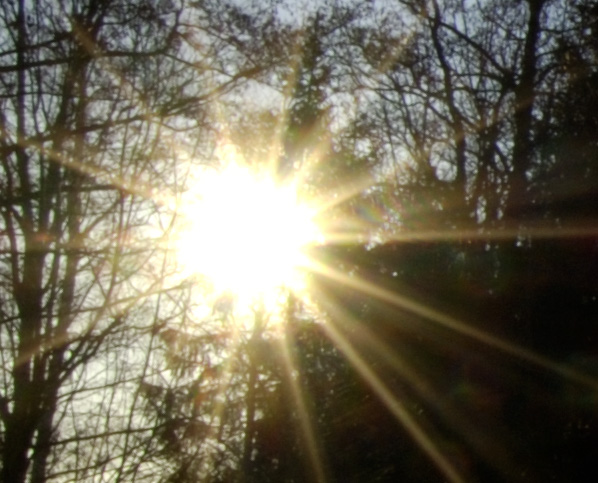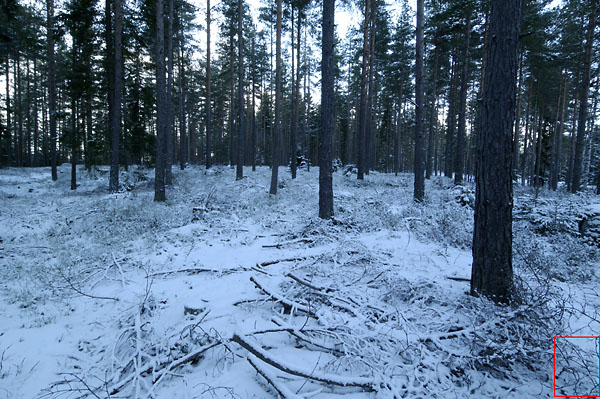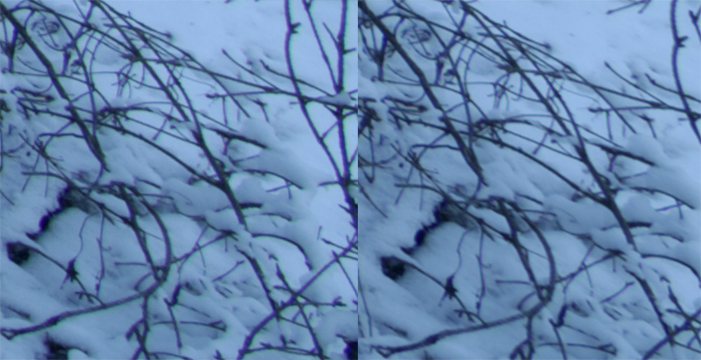 |
|
| Straight
into the Sun D2X, 12-24DX mm f/4 Nikkor,100 "ISO" at f/22, 1/20 sec. Crop shown at 100% (actual pixel size) © Bjørn Rørslett/NN |
| Nikon D2X Digital Camera Reviewed | |
| by Bjørn Rørslett | |
4.
Noise Performance and Image Imperfection Issues
Digital image noise might be obtrusive, but a virtually noiseless digital image can in fact be perceived as cold and sterile. Thus, not all kinds of noise are bad as far as photography is concerned. Just rewind your memory to the old glorious days of souped Tri-X when megagrain (not megapixel) was in the vogue.
I think we quite easily accept some noise in the images when that noise manifests itself sufficiently random, in nature as well as in its spatial distribution. Visual patterns of noise, and in particular banding of the image, are far more objectionable. Unfortunately the artifical kind of noise we have seen in the past with many DSLRs (from Nikon and their competitors as well) has earned the notion of digital noise a bad reputation in some photographic circles. In a manner of speaking, such noise detracts from the image content in the way that poor digital records grate on the ear.
Underutilization of the dynamic range of the digital imager is a major putative candidiate for noise generation. This occurs either by user error (underexposure) or by deficiencies in the metering system of the camera emphasizing highlights instead of shadows when scene contrast is high. I believe the matrix metering system of D2X try to prevent highlights to blow out and thereby sometimes allows the shadows to get too dark. The end result is an image with perfect highlights and shadows in which traces of colour noise can appear. The cure for this is simply to expose a little richer, or thinking about how you did shoot negative instead of slide film in the dark ages so many moons ago. When scene contrast is moderate however, the metering accuracy of D2X is uncannily spot-on all the time.
If you underexpose severely, banding tend to occur on most DSLRs and this is well known from the D2H. Unlike D2H, however, D2X is not much troubled in this area. The graininess of the image will increase by underexposure, of course, but the banding issue simply isn't there to any noticeable extent. The chrominance noise is quite randomly distributed.
Automatic white-balance is another less readily recognised culprit causing digital noise. We have become sloppy technicians preferring to click a button in software to get a "white" rendition instead of attaching a colour-balancing filter to the lens. Thus when shooting under incandescent lighting and setting the colour balance by automatic means, we are (but shouldn't be) surprised and annoyed by appearance of blue-channel noise, and don't consider the tremendous additional boost of blue colours needed to balance a blue-deficient light (incandescent light) as white. If you combine incandescent light sources and severe underexposure, the end result will show visible blue channel noise. Obviously you should have such results, but still some people need to be reminded of facts before they start complaining about camera "flaws".
A final way of avoiding noise is to max out aperture (and/or shutter speed) before you dial in a higher "ISO" setting on the camera. I find I can achieve virtually noiseless images with the 58 mm f/1.2 Noct-Nikkor, one of my pet lenses for D2X, at 100 "ISO" and f/1.2-f/1.4 @ 1/4 sec instead of setting it to f/2.8, use 1/15 sec and increase "ISO" to 800 - 1600.
So, let's investigate various aspects of the image rendition of D2X. First out , the issue of "blooming", which can result from massive overexpoure of the imager, typically when you shoot into the sun. I did exactly this with my 12-24DX lens set to f/22, and here is the result :
 |
|
| Straight
into the Sun D2X, 12-24DX mm f/4 Nikkor,100 "ISO" at f/22, 1/20 sec. Crop shown at 100% (actual pixel size) © Bjørn Rørslett/NN |
I consider the "blooming" issue to be largely non-existant with the D2X, while on D70 at least it could be a nasty issue unless you followed the practice of stopping the lens down and setting the exposure to the lean side. This welcomed trait of D2X implies you can include bright spots of light into your images without fear of getting image anomalies.
By the way, shooting into the sun is something you should do with great care, your eyes may not like the intense glare any more than does the imager in the camera. If you shoot into the sun (typically with wide-angle lenses), always remember to stop down to the smallest aperture value available on your lens. The only exception to this rule is when you shoot sunsets with telephoto lenses, a situation in which you normally wish to have the solar disc as large as possible, and hence should set the lens to be wide or nearly wide open. However, don't ever try to do this unless the sun is just about to set, or is enshrouded in a thick cloud layer.
 |
|
| Coniferous
Forest and Snow D2X, AFS 12-24 f/4 DX Nikkor, 100 "ISO" at f/16, 1 sec. The crop in red is shown enlarged below © Bjørn Rørslett/NN |
A significant claim made by Nikon in defense of their smaller-sized "DX" format, is that DX lenses mitigate issues such as light fall-off into the corners, and the ills of chromatic aberration. I found virtually no signs of light fall-off for any of my DX-type lenses, so the claims seem corroborated for field shooting. However, CA is a nasty and persistent optical gremlin and in fact, CA issues hardly visible with D1X or its ilk became plainly visible with the D2X, if the image is scrutinised under high magnification. Thus, higher resolution doesn't come free. Again, we have to keep a perspective on the issue. Do you see CA in the left picture below? This is by the way equivalent to looking at a 16 x 20 " print at close range.
 |
|
| Chromatic
aberration (CA) with the 12-24 DX Nikkor lens @12 mm Vestiges of chromatic aberration (CA) can be seen on the crop (left panel). Purple and green colour fringing is evident along the branches. The right panel shows the result of running the Correct module of Panorama Tools on this image, and evidently the CA can be removed to a great extent. Is this amount of CA important? The answer certainly depends on the ways in which the image should be used, so a reduction of CA may be needed for an exhibition print, but not for prints in newspapers or magazines. For web use the CA issue is purely academic. |
I intend to compile a list of lenses which performed well with D2X. I haven't decided yet whether this list will be added to the present review, or published to a separate page. An initial and interesting observation is that AFS 17-35/2.8 Nikkor, not a DX-type design, showed equal or less issue with CA at its 17 mm setting than did the AFS 17-55/2.8 DX Nikkor. Another finding is that several of my trustworthy long lenses, such as for example the AIS 400 mm f/2.8 or AIS 300/4.5 ED-IF Nikkors, exhibited far more visible CA with D2X than with any of the D1-series cameras I've usedthem on earlier. Telephoto lenses originating in the early '80s often had a basic design comprising 8 elements in 6 groups, and I fear the chromatic correction of these lenses even with all their ED glass is insufficient to cope with the more stringent demands of the high-resolution D2X imager. In contrast, my more recent AFS telephoto lenses (for example, AFS 300/2.8 Mk.I and AFS 200/2 VR Nikkors) behaved much better on the D2X. My venerable traveling companion, the 50-300 mm f/4.5 ED Zoom-Nikkor, performed very well on D2X, up to the long end which showed some increase in CA. On the other hand, my 14 mm f/2.8 Nikkor although sharp, simply had too much colour fringing into the corners for my taste. So, many lenses are demasked by D2X, and some will give pleasant surprises.
* * *
The final issue to be addressed is that of "ISO" noise. For some strange reason, inscrutable in a true Oriental fashion, photographers (or more likely, gearheads masquerading as photographers) have become obsessed with "noise" at astronomically high ISO speeds, even if these are outside the approved camera settings. Each to his own, but I frankly cannot see the relevance for some of these heated debates. People should try faster lenses or make other improvements to their technique before complaining about noise at 3200 ISO equivalency. Or try 3200 ISO film, that'll teach them a lesson in what's relevant. Off the soap-box, back to the review.
D2X has a nominal ISO equivalency range of 100-800, and additionally HI-1 and HI-2 settings. The pixel pitch of the D2X imager is 5.5 µm, which is the smallest among any Nikon (or Canon) DSLR. Many advocates of a full-frame (FF) digital solution feared (or hoped, depending on brand loyalty) that the smaller dimension of the pixels of D2X should give unpleasant noise effects. So how can D2X stand up to expectation?
The statistics I derived for ISO noise are displayed on the graph below, indicating that the noise level of D2X is kept under quite strict control. Despite its smaller pixel pitch, D2X performs much better than D70 (and D2H, not shown). The camera has user-selectable "HI ISO" noise reduction settings, where you can set NR to "Off", "Normal", or "High". I was in the first round of tests a little baffled by these settings because my results were inconsistent. Later, when I got the manual for the camera, I found out that HI-1 and HI-2 setting always have NR on, no matter which option the user has selected. "Hi ISO" in fact commences at 400, so any ISO equivalency below that isn't influenced by the NR at all. NR aggressiveness at HI-1/HI-2 increases with NR settings "Normal" and "Strong".
|
|
| Measured image noise
from D2X and D70 run across the entire ISO rnage of each
camera. Standard deviation measured on (RGB) data on
images taken under "real world" conditions,
with the AFS 300/2.8 lens at f/5.6, Hi-Iso NR set to
"Normal" which is the default. Nikon would designate 1600 ISO settings on D2X as "HI-1" and "HI-2", respectively. The EXIF output in Nikon Capture 4.2 states likewise 1 respective 2 stops above ISO 800. |
You are entitled to draw your own conclusions of course, but I for one won't hesitate upping the "ISO" equivalency if needs dictate so. Nikon has designated the two upper levels as "HI" and won't give an "ISO" number for them, and the images do show they are more noisy than the approved range of 100-800 "ISO". However, image detail is sharply rendered and the noise can be mitigated to some extent by dedicated noise removal software. I've seen several interesting pictorial avenues to be explored by the D2X running in "HI" mode.
Most photographers, however, prefer to focus on what information they might glean from pictures and thrive less on statistics alone (I'm talking about real photographers here, not photography gearheads). In order to feed that insatiable crowd, I prepared a series of test images which are detailled below.
|
|
| This idyllic
homestead, located on Maridalsvann lake, is amongst my
standard test motifs. The shooting distance is exactly 2
km so I tend to deploy a 300 mm or longer lens, here an
AFS 300 mm f/2.8 Nikkor . The crop area, outlined in red, is exhibited at full 100% resolution for 100 to 3200 ISO equivalencies by clicking the appropriate link below. Please note the cropped images still are some 275 KB in size ! (Use the Back button of your browser to return here)
No image sharpening or other adjustment has been applied to these crops. They are jpgs converted straight from the NEF files in Nikon Capture 4.2. Note that some NR always is on for ISO 400, 800, HI-1 and HI-2, this is not user configurable. When you select "Normal" or "Strong" NR, this comes on top of the basic NR already taking place. This additional NR isn't conducted in camera for a NEF, but instead written as an instruction set to the file. Nikon Capture subsequently reads and processes these instructions, but other raw converters (e.g. Bibble), just ignore them. |
As you increase the ISO equivalency, the image becomes a trifle noiser and from 800 ISO and up, a steady rise in the loss of shadow detail is evident. Colour rendition gets more muted on the "Hi" ISO settings, too. Still, the image quality achieved in the non-approved "HI" range (1600 and 3200 "ISO") is perfectly usable for a great number of assignments.
In the last test series, run with my own camera, I found image detail sharpness to be improved at ISO 400-800 with NR turned "Off", and even more so at 1600-3200 (HI-1, HI-2). However, in the latter case (Hi-2) the chrominance noise may be quite visible. Be aware that a basic NR is in effect for ISO values above 400 even if the user has switched off NR from the menu. This fact is duly reported in the EXIF header, but Nikon Capture at least won't differentiate "Normal" and "Strong" mode (this flaw is corrected in the newest 4.4 version).